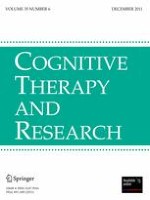01-12-2011 | Brief Report
Do Metacognitions Predict Attentional Bias in Health Anxiety?
Gepubliceerd in: Cognitive Therapy and Research | Uitgave 6/2011
Log in om toegang te krijgenAbstract
The Self-Regulatory Executive Function (S-REF) model predicts that dysfunctional metacognitions are fundamental to the development and maintenance of emotional disorder, as they contribute to a perseverative style of processing: the Cognitive Attentional Syndrome (CAS). The aim of this study was to test the relationship between dysfunctional metacognitions and attentional bias (a component of the CAS), in the context of health anxiety. 158 undergraduate students read information on health risks as part of a health anxiety induction before completing an emotional Stroop task, and a number of questionnaires. Although the health anxiety induction may not have been successful, health-specific metacognitions were associated with attentional bias for health-related words, positive words, and also a greater bias for positive words when they were related to health (rather than general). Only one dimension of general metacognitions (“negative beliefs about worry, concerning uncontrollability and danger”) was associated with attentional bias. Findings are discussed in relation to the predictions of the S-REF model, and directions for future research are outlined.
